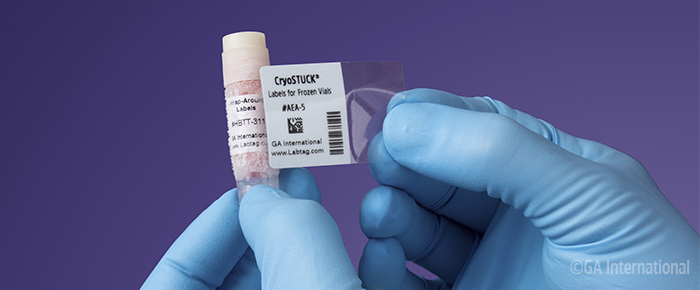
What are legacy vials?
The term “legacy vials” is meant to characterize pre-existing samples that have been frozen prior to the installation of a LIMS or other lab management system. These systems necessitate the use of digital laboratory management, including the implementation of complex tracking and tracing systems. To fully integrate a lab management system, legacy vials must be accurately labeled, such that they can be properly identified in the new system.
What is the best way to re-label them?
The primary problem when re-labeling (also termed over-labeling) legacy vials is unnecessary thawing. Legacy vials should be re-labeled at temperatures below -70°C so that their contents are properly preserved and not degraded. However, because most labels do not adhere to frozen surfaces, users used to thaw and wipe the vials clean before affixing the label, with this freeze-thaw cycle damaging the contents.
To properly label legacy vials, it’s imperative to use labels that will affix to frozen surfaces, such as CryoSTUCK®. These labels can be applied at -80°C then stored in liquid nitrogen tanks (-196°C) or low-temperature freezers for further preservation. If samples aren’t to be re-labeled immediately upon removal from liquid nitrogen, it’s best to keep them on dry ice to preserve their integrity. Handling too many samples at once may also result in unnecessary thawing, so it’s imperative to split vials into small batches that can be re-labeled quickly and efficiently. Working in teams of 2 is a good way to expedite the process. Additionally, using a vial holder, such as the CryoHolder made by PharSol, represents a relatively quick way of removing vials from storage and avoiding excess thaw.
If the vial has a label with obsolete, or incorrect information that cannot be removed, then a Blackout CryoSTUCK label can be used to block-out the old label. For labels that are intact but require an additional layer of protection, Clear CryoSTUCK labels can be used to over-label the vial, providing secure lamination without obscuring the information on the label.
For legacy vials that are identified via handwriting, it’s recommended to use cryogenic labels printed with both human-readable text and barcodes. The human readable interface, or HRI, as it is referred to in the industry, is simply an alphanumeric representation of the information encoded by the barcode. It is useful when a barcode scanner is not available and a quick visual identification is required. Barcodes will make adding the samples to your inventory management system quicker, and easier, and also streamline sample tracking. Barcodes can be printed using either a laser or thermal-transfer printer, with our CryoSTUCK labels offered in both formats. Labels printed using thermal-transfer printers provide the maximum protection against extreme lab conditions, including cryogenic storage, and are the recommended option, though most labs already have a desktop laser printer, making them a more economical choice.
Why label legacy vials?
The need for properly labeled samples arises when installing an inventory management system into your lab. This usually includes protocols on how to label samples going forward, but existing tubes and vials need to also be added to the system for the purposes of tracking and inventor management. This typically is part of the larger process of digitizing the lab, which will involve digital protocols, workflows, and notebooks, in the form of an electronic lab notebook (ELN). An ELN in combination with an inventory management system can be used to properly track the location of every sample in your low-temperature freezers and liquid nitrogen tanks, down to the rack, box, row, and column. This will ensure you always have an up-to-date picture of your inventory, making planning experiments easier, and reducing the risk of having to halt an experiment due to lacking enough samples or reagents. This also eliminates the necessity of identifying hand-written information, generated by a colleague who is unavailable for consultation.
Once a lab management system is finally set up, it’s important to maintain the use of cryogenic labels, which are designed for extremely low temperatures, as any other type of label will likely fail after even a short period of incubation in liquid nitrogen. There are many different varieties of cryogenic labels, each with different features, but for the general storage of tubes or vials stored in liquid nitrogen, NitroTAG® is recommended.
LabTAG by GA International is a leading manufacturer of high-performance specialty labels and a supplier of identification solutions used in research and medical labs as well as healthcare institutions.